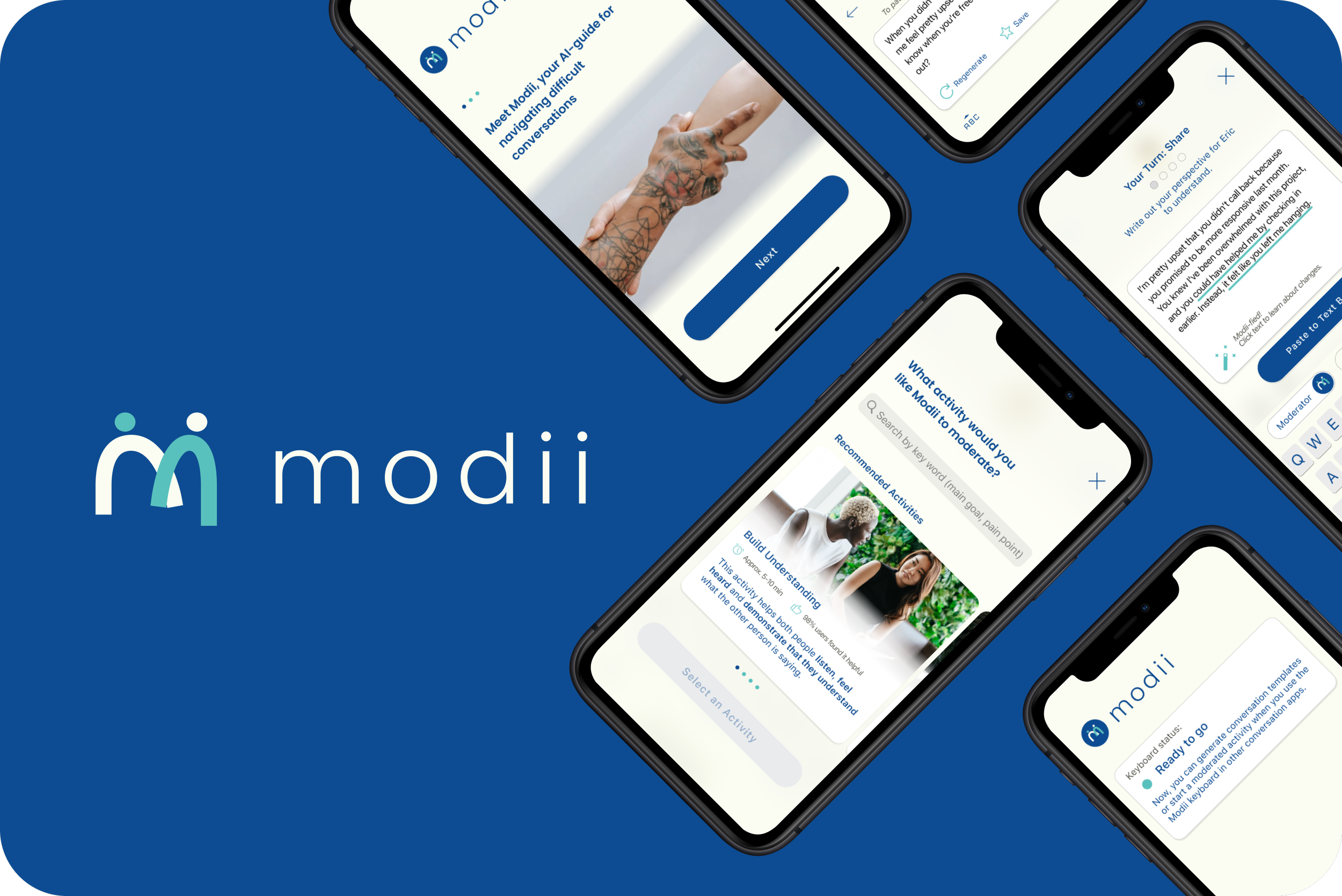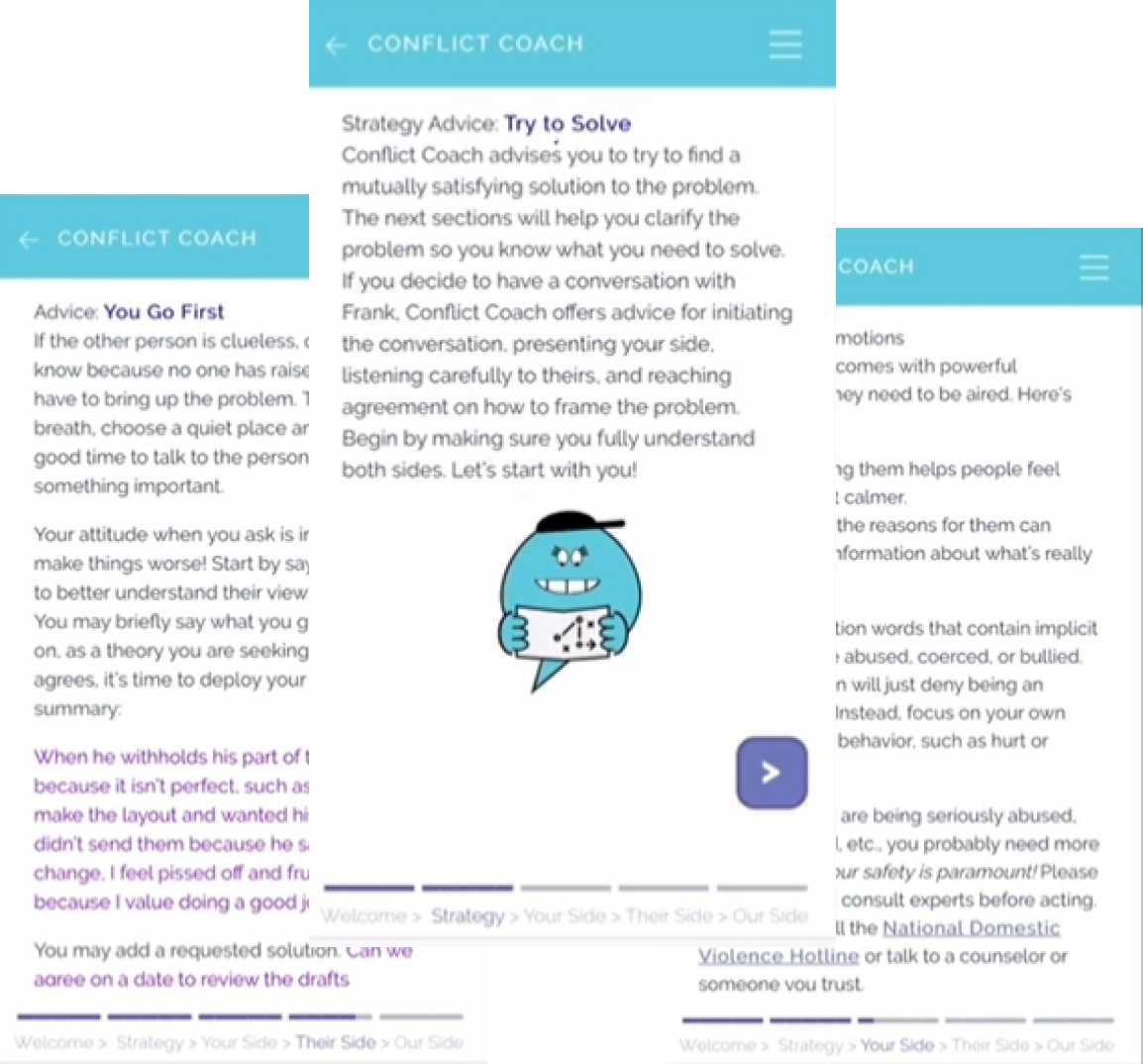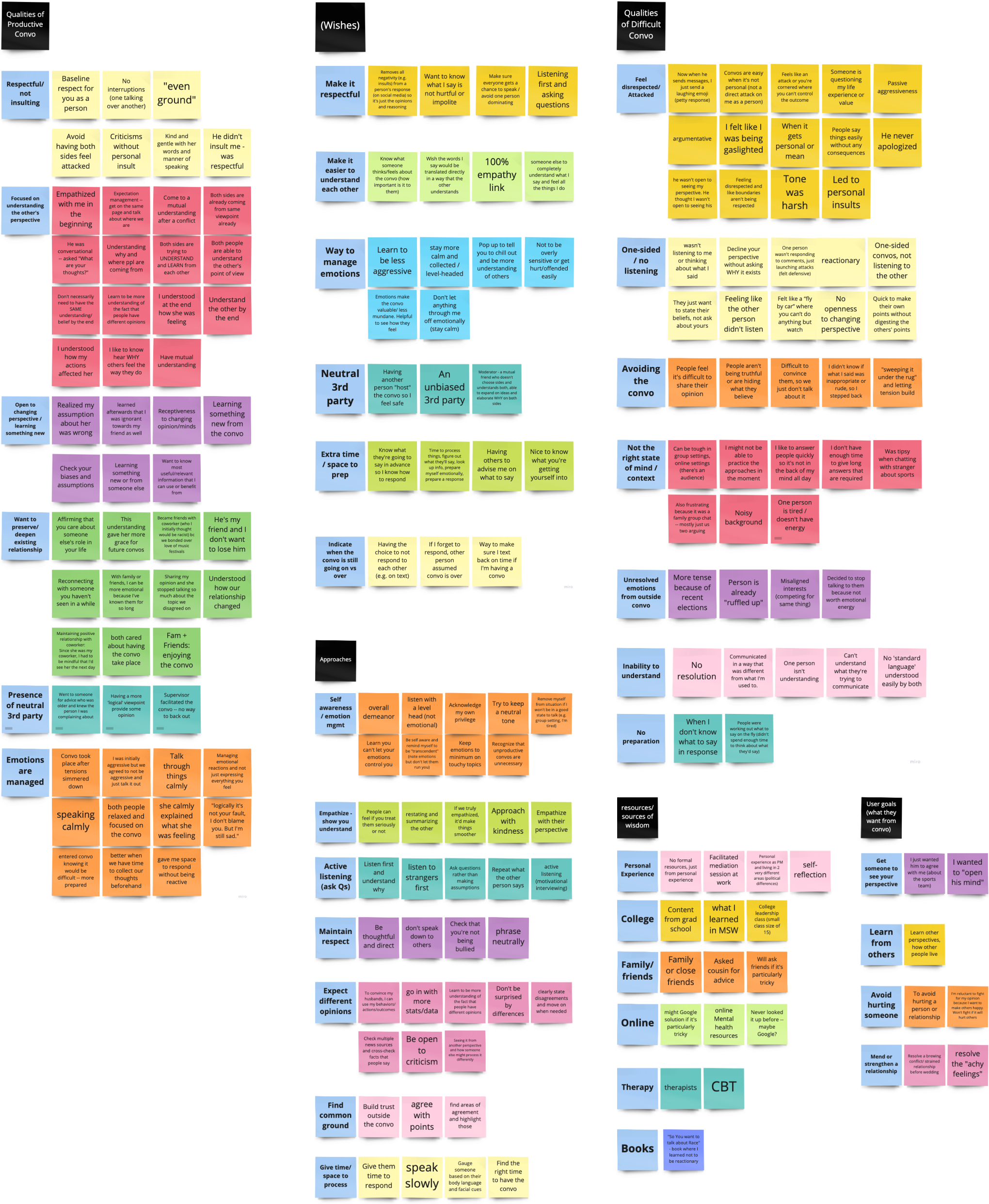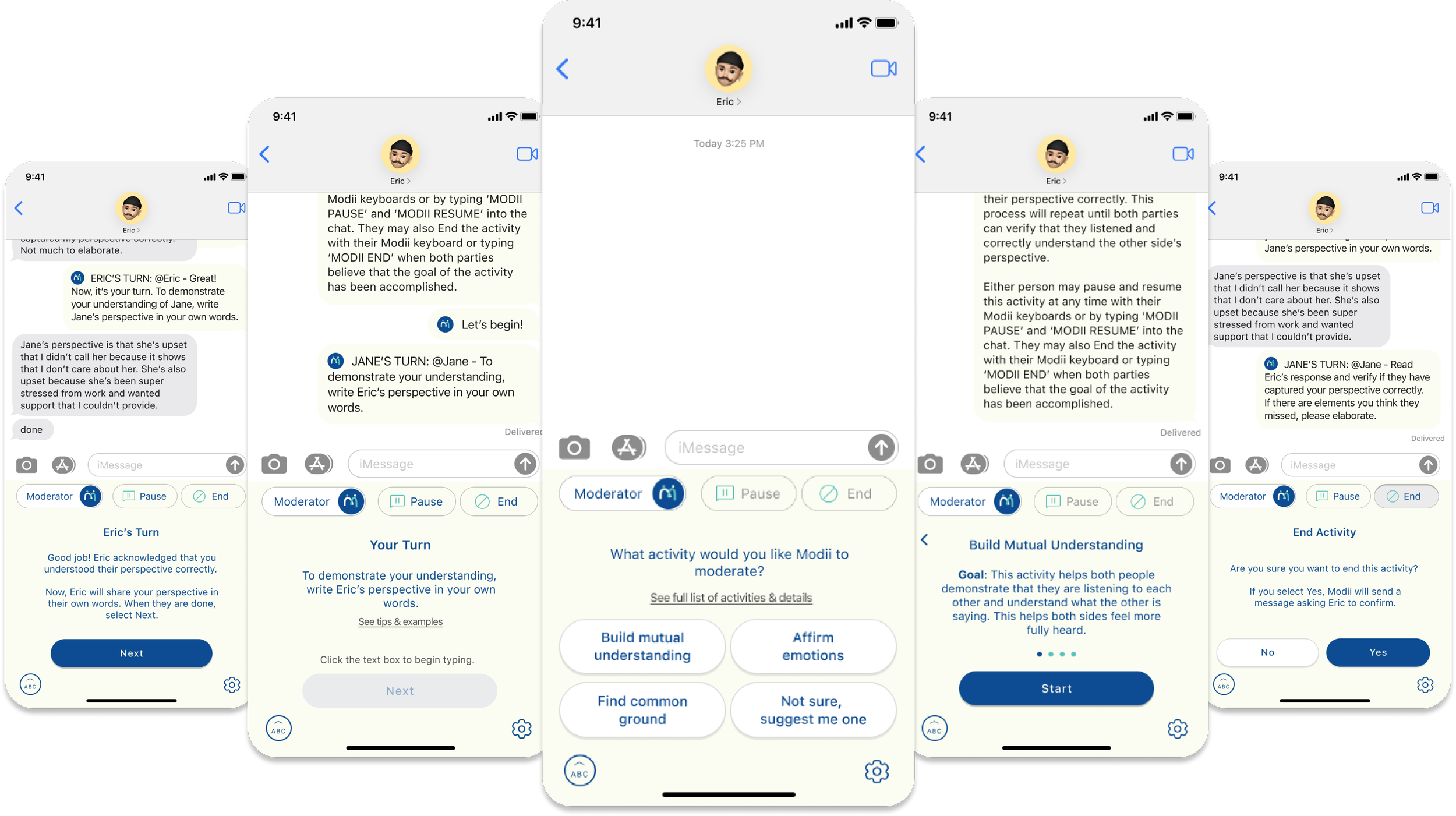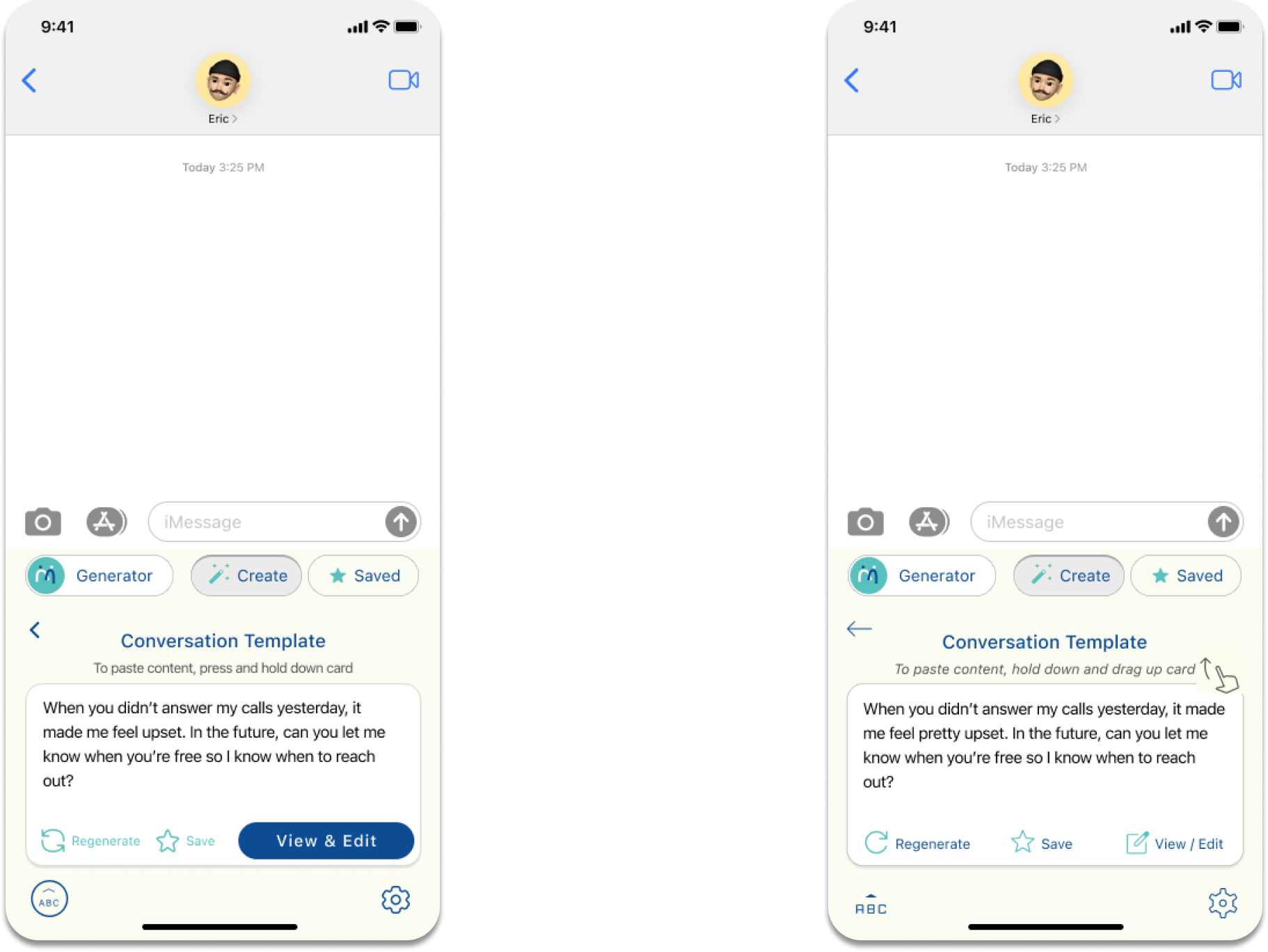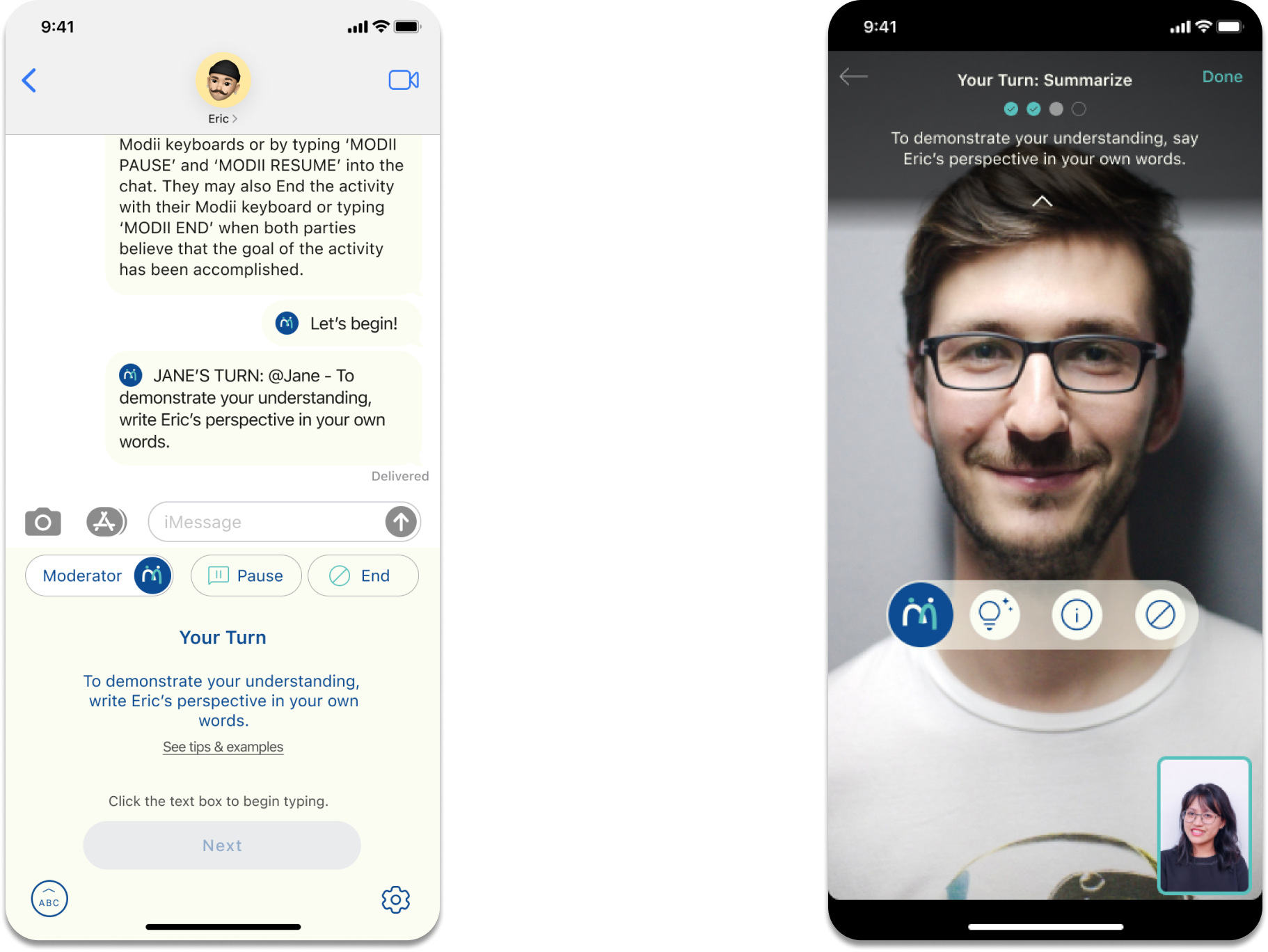modii
designing a mobile AI-solution that simplifies difficult conversations
Timeline: Oct 2022 - Jan 2023
My role: Solo UX/UI Designer & Researcher
Tools: Figma, Miro, Marvel, Fable
Problem
It all started with a heated argument between my roommates. Both sides were angry, indignant, and unwilling to listen to each other’s side — it was a microcosm of a national phenomenon within politics.
I realized: our inability to productively engage with people with different beliefs not only hurts our relationships, it also drives chasms between entire communities in society.
So…how can we make it easier to engage effectively in difficult conversations?
Solution
This question led me to conduct research, ideation, design and testing to create Modii, a mobile AI-solution that helps people navigate difficult conversations and disagreements in real-time.
Modii provides tailored conversation suggestions, templates and conflict-resolution activities in an embedded 3rd-party keyboard.
With Modii, participants can confidently and productively engage in disagreements whenever they arise.
Final Design
Meet Modii, your helpful guide for navigating difficult conversations when you need it most
Set up the Modii keyboard and make Modii one tap away in all your conversations
Use Modii to come up with more productive ways to express yourself in heated conversations
Use Modii as a neutral moderator to guide both people through a real-time conflict resolution activity
Process
Discover | LANDSCAPE REVIEW
A landscape review found increasing concerns around polarization, yet very few solutions
Main findings:
Polarization is an increasingly serious problem in the US that divides communities across racial, political, and other lines
While there are frameworks that help us understand conflict at multiple levels, there are few organizations or solutions that promote conflict resolution in an easy-to-access way
Very few mobile solutions related to conflict resolution exist. The closest competitor, Conflict Coach App, was neither accessible, comprehensive, nor helpful during conflicts.
Discover | INTERVIEWS
Difficult conversations are important, but can fail without proper structure or incentives
I conducted a brief demographic survey and 7 semi-structured interviews to understand:
How do people currently engage with others who have different beliefs/values?
What are their key challenges and considerations?
What existing solutions do individuals use to navigate difficult convos?
Initial takeaways:
1) Individuals agree that conversations with those we disagree with are important and often necessary (for work, relationships, etc.)
2) There is no common technology solution that makes such conversations easier
“He wasn’t open to seeing my perspective... I decided not to even talk to him because it’s not worth my emotional energy.”
— Participant 1
“The conversation depends on if it’s with friends or family. If I know it won’t hurt the relationship, then I’ll share my real thoughts.”
— Participant 2
“The conversation started okay, and then led to...personal insults. At the time, I just wanted them to agree with me.”
— Participant 3
Define | AFFINITY MAPPING
Context and personality affect how individuals behave in difficult convos
Top Insights
People can have vastly different approaches to engaging in conflict based on contextual factors, including personality, conversation partner, conversation medium, etc.
Negative emotions like anger can override knowledge about the “right thing to do” in the moment
Participants want to understand and feel understood, but may feel like they don’t share the same intelligible language as the other person
Define | PERSONAS
Defining personas by conflict styles helped me isolate and adapt to users’ needs
I developed 3 personas to identify key user needs, largely inspired by the conflict styles in the Thomas-Kilmann Conflict Management Model.
Ultimately, all the personas share a common goal of gaining confidence in saying/doing the right things in a difficult conversation, but have different sub-needs related to their conflict style.
Persona 1
Taylor the COMPETITOR
-
Confidence in being able to clearly express and defend my ideas to others
-
Easily express myself
Have my thoughts and/or feelings acknowledged by the other person
Regulate my emotions so they’re not draining
Get to a fast resolution
-
Moderating and managing my negative emotions in a conversation so I can get my point across
Lacking a common, mutually-understood “language” in the conversation
Persona 2
Marcy the AVOIDER
-
Emotional security and self-confidence when approaching difficult conversations
-
Avoid hurting or insulting others
Avoid feeling “trapped”
Protect my sense of emotional wellbeing/energy
-
Feeling like the conversation is too emotional or draining to be worth my time
Not knowing if what I say could be insulting or relationship-threatening
Not enough time to prepare myself mentally and emotionally for a conversation
Persona 3
Clark the TEAMMATE
-
Accountability for both people in the conversation to find a resolution together
-
Come to some kind of resolution that both parties are satisfied with
Understand the other person’s thoughts and feelings
Build a stronger relationship with the other person
Express own thoughts and feelings safely
-
Not being able to track what’s been said already and why
Being unable to tell what the other person is thinking or feeling
Having unresolved tensions from outside this particular discussion
…accommodate individuals’ different conversation contexts & mental states to achieve a productive conversation in the moment?
How Might We…
Define | PROBLEM STATEMENT
Individuals need real-time support and confidence to have constructive conversations with others, because these conversations can cause stress and relationship breakdown.
Develop | IDEATION
Using generative brainstorming, I selected the most promising ideas:
1) conflict styles profile quiz
to help users learn about their own conflict tendencies and how to address them
2) convo template generator
to help users phrase themselves in productive ways in the moment of conflict
3) real-time virtual moderator
to establish ground rules and guide users through a conflict resolution activity
Develop | USER STORIES & FLOWS
User stories with the most value and the least amount of effort were prioritized for the MVP
Top priority stories:
As a user (all conflict styles), I want to take a survey to identify my conflict style, so I can view/receive tailored results & recommendations.
As a user (all conflict styles), I want to create customized conversation templates so I don’t have to spend energy or time worrying about what the best phrasing is.
As a user (all conflict styles), I want to select and start a moderated activity with my conversation partner so I can have guidance/support working through a specific conversation context.
Afterwards, mapping out initial user flows for the red routes helped me envision the solution as a native mobile app + embedded 3rd-party keyboard:
Design | SKETCHING & GUERRILLA TESTING
Initial guerrilla testing on sketches found that users needed more explanation of the solution
I created rough sketches and conducted guerrilla testing on 5 potential users (using Marvel) to get initial reactions on the solution’s core features and update flows/wireframes.
Key Issues & Fixes
Issue 1: Need more context
Users didn’t understand how the conflict style quiz connected to the 3rd party keyboard
Solution: Given limited time to add an entirely new flow, I replaced the conflict style quiz flow with an onboarding flow that included details on the app’s purpose
Issue 2: Need to prevent accidents
Users were afraid they might accidentally a message to another person from the keyboard
Solution: I added an additional security check for sending messages (hold and swipe up instead of just click)
Issue 3: Confusion around wording
Users were confused by the wording of the moderated activity choices
Solution: I updated the phrasing to emphasize the activity’s end goal/benefit
Design | BRANDING & STYLE GUIDE
To bring the solution to life, I created a brand ecosystem that reflects the solution’s vision
Brand Name: Modii
Vision: To cultivate a more collaborative & empathetic world, one conversation at a time
Brand Attributes: trustworthy, friendly, proactive, neutral, attentive
Logos
Color Palette
Typography
Flow 1: Set up the Modii keyboard
Flow 2: Generate & use a custom conversation template over text
Flow 3: Start a moderated activity over text
Design | USABILITY TESTING
Two rounds of usability testing refined features to achieve a 100% task completion rate
I conducted 2 rounds of remote moderated usability tests on the hi-fi screens (n=11) to identify and resolve user issues.
By Round 2 (n=6), all issues from Round 1 were successfully addressed, and 100% users said they found the solution useful and would use it themselves.
Key Issues & Fixes
Issue 1: Hard to differentiate options
Users could not differentiate between Moderate and Generate options; one user chose incorrectly
Solution: Provided clearer descriptions for Moderate and Generate features, and animated menu toggle so users are aware of its function
Issue 2: Didn’t notice key action
80% users didn’t see the option to paste the text box by clicking and dragging
Solution: Added animation and larger icon to draw attention to swiping action
Issue 3: Didn’t notice instructions
40% users didn’t fully understand the moderated activity even after reading the instructions
Solution: Dedicated more visual space to explain instructions so users wouldn’t overlook them
Additions from Expressed User Needs
Addition 1: “Modii-fy” words
I added a “Modii-fy” feature to allow Competitor and Avoider personas to phrase words when completing the moderated activity and adjust any (passive) aggressive language before sending
Addition 2: video-based moderation
I designed a few screens of a video-based moderated activity to make users feel more invested in the discussion, as a few users mentioned that they would prefer to have a video or voice-call option for the moderated activity
Final Interactive Prototype
Some Big Takeaways:
-
Some users mentioned that this app would be great for those who have the right intentions, but some people could abuse certain features to manipulate others. I made design changes to minimize the risk of such abuse, but ultimately, I can’t prevent all negative outcomes without creating a poorer user experience.
-
I heard different things from various mentors on how to create personas (e.g., 1 persona to capture the main goal vs. many personas to capture sub-goals). I ultimately decided to move forward with multiple personas that helped me ideate and ensure my solution addressed different sub-needs.
-
During most of my initial testing rounds, users were confused about an unfamiliar feature until they saw a screenshot or animation of its final state. This project emphasized to me how important animations are in being functional as well as delightful.
-
When prioritizing red routes, I initially left out the virtual moderator feature because I thought it would be technically impossible. In speaking with a mentor and realizing the solution should prioritize solving user needs, I brought it back (to the joy of my interviewees). I later checked with a AI engineer and verified that this solution isn’t entirely impossible after all!
What’s Next:
Test some more.
Conduct further testing on additional elements of existing features including additional moderation activities and the video-call moderated activity features.
Measure.
Capture KPIs, including: user satisfaction, user sentiments before and after using features, completion rate of moderation activities, growth in user base.
Iterate.
Based on feedback, continue to iterate and work (especially with an AI developer) to address technical constraints within the current solution’s design.

